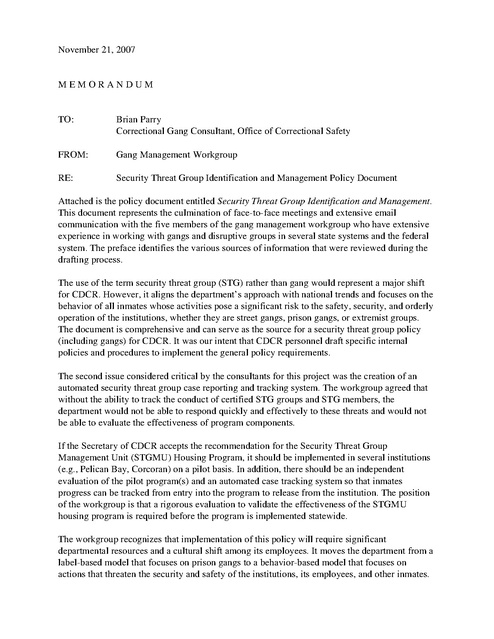Ca Gang Management Workgroup Memo Re Gang Identification and Management Policy 2007
Download original document:

Document text

Document text
This text is machine-read, and may contain errors. Check the original document to verify accuracy.
November 21, 2007 M E M O R A N D U M TO: Brian Parry Correctional Gang Consultant, Office of Correctional Safety FROM: Gang Management Workgroup RE: Security Threat Group Identification and Management Policy Document Attached is the policy document entitled Security Threat Group Identification and Management. This document represents the culmination of facetoface meetings and extensive email communication with the five members of the gang management workgroup who have extensive experience in working with gangs and disruptive groups in several state systems and the federal system. The preface identifies the various sources of information that were reviewed during the drafting process. The use of the term security threat group (STG) rather than gang would represent a major shift for CDCR. However, it aligns the department’s approach with national trends and focuses on the behavior of all inmates whose activities pose a significant risk to the safety, security, and orderly operation of the institutions, whether they are street gangs, prison gangs, or extremist groups. The document is comprehensive and can serve as the source for a security threat group policy (including gangs) for CDCR. It was our intent that CDCR personnel draft specific internal policies and procedures to implement the general policy requirements. The second issue considered critical by the consultants for this project was the creation of an automated security threat group case reporting and tracking system. The workgroup agreed that without the ability to track the conduct of certified STG groups and STG members, the department would not be able to respond quickly and effectively to these threats and would not be able to evaluate the effectiveness of program components. If the Secretary of CDCR accepts the recommendation for the Security Threat Group Management Unit (STGMU) Housing Program, it should be implemented in several institutions (e.g., Pelican Bay, Corcoran) on a pilot basis. In addition, there should be an independent evaluation of the pilot program(s) and an automated case tracking system so that inmates progress can be tracked from entry into the program to release from the institution. The position of the workgroup is that a rigorous evaluation to validate the effectiveness of the STGMU housing program is required before the program is implemented statewide. The workgroup recognizes that implementation of this policy will require significant departmental resources and a cultural shift among its employees. It moves the department from a labelbased model that focuses on prison gangs to a behaviorbased model that focuses on actions that threaten the security and safety of the institutions, its employees, and other inmates. We believe that the department will be better served with this new focus because in addition to gangs, correctional departments nationwide must be prepared to deal with other disruptive and violent groups, including extremists and terrorists. The policy also imposes stricter conditions of confinement on inmates who threaten institutional security, conditions that are similar to other state systems and the Federal Bureau of Prisons. The policy institutes a phasedbehavior management program that reinforces nondisruptive behavior. This program is intended to decrease gangrelated activity and reduce the time spent in special housing units. The members of the workgroup appreciate the opportunity to assist CDCR in its review of existing gang control strategy and to make recommendations for a departmental change in its policy. We are available to meet with you and your staff to discus the basis of our recommendations and answer questions. cc: Gang Management Workgroup: Dale Artus, Superintendent, Clinton Correctional Facility, New York; Ben Griego, Former Assistant Director, Colorado Department of Corrections. Currently working in the private prison industry field; William Sondervan, Ed.D., Former Commission, Maryland Department of Corrections and Director of the Criminal Justice Program at University of Maryland, University College; John Vanyur, Ph.D., Former Assistant Director, Federal Bureau of Prisons. Currently working in the private prison industry field; and David Ward, Ph.D., Emeritus Professor, University of Minnesota and Principal Investigator of a federallyfunded study of the effects of longterm confinement under conditions of federal super maximum custody. Sacramento State University (SSU) Research Team Miki VohryzekBolden, Professor and Research Team Leader, SSU Marlene Franz, Contract Administrator, Deliverable 5, 512872 Attachment





